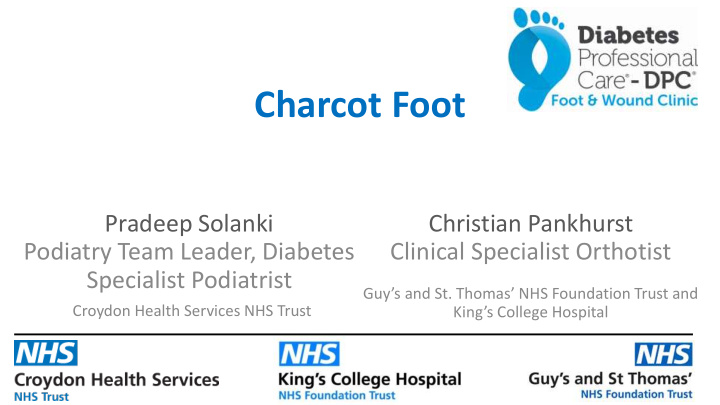



Charcot Foot Pradeep Solanki Christian Pankhurst Podiatry Team Leader, Diabetes Clinical Specialist Orthotist Specialist Podiatrist Guy’s and St. Thomas’ NHS Foundation Trust and Croydon Health Services NHS Trust King’s College Hospital
Charcot Foot • Learning Outcomes • Understand the definition of a Charcot Foot • What leads to a diagnosis of Charcot • Understand what makes the foot in diabetes so vulnerable to developing Charcot Osteoarthropathy • Key tips to share with patients to prevent the development of a Charcot • Understand the impact a Charcot has on a patient / clinical outcomes • Be aware of what treatments are available for Charcot • When to refer on and how you would find out to whom to refer to
Aim • Introduce the Charcot foot syndrome • Look at the presentation of the condition • Explore short and long term treatment goals • Enable you to feel more confident in spotting a Charcot and what to do
Definition • Osteoarthropathy -Neuro arthropathy - Foot Syndrome • Affects people with dense sensory neuropathy • And also neuro-ischaemia (e.g the renal patient) • Characterised by oedema, inflammation, heat, change in foot shape- deformity, bone fractures, deep ache/pain
Clinical Presentation A Charcot deformity in a neuroischaemic foot renal patient Pedal artery calcification Mid foot bones affected subluxing
Other causes.. Uncommon condition that is associated with the neuropathic condition now mostly diabetes. The prevalence appears to be underestimated- due to a lack of awareness of the condition- reports vary 3 per 1000 up to 7.4 per 1000 (Hispanic population) Charcot also seen in: Tertiary syphilis- tabes Dorsalis (neuro syphillis), Alcoholism Hanson disease (Leprosy). & mainly… Diabetes mellitus
The actual cause is poorly understood: • In susceptible Person – where there is established sensory neuropathy possible minor trauma event. • Sensory neuropathy (reduction or absence of the gift of pain) , could mean that patient continues to weight bear on foot despite some bony changes, where normally pain would be a limiting factor… • An episode of inflammation in the foot becomes protracted (due to the neuropathy, Immune mediated process involving cytokines that promote bone destruction by the activation of osteocytes). • Bone density reduces, resulting in bone architecture becoming osteopenic , bony fractures, dislocation, deformity • Very destructive process that can progress quickly… requires early referral and review.. • NB not just restricted to the neuropathic foot.. Also the ‘renal foot’
Differential diagnosis • DVT • Osteomyelitis • Proximal blockage • Bone tumour • Other fracture
Phases of the Charcot foot syndrome i)The active acute destructive phase ii)The consolidation remodelling phase iii)The quiescent phase
Management: Acute destructive Phase If you suspect a Charcot- refer immediately to your local specialist Multi Disciplinary clinic (know who to contact!) Need to establish a diagnosis: Take a history, Plain film x ray, exclude Osteomyelitis, DVT, gout, infection from another source, ankle sprain, Possible use of Mri imaging, blood tests maybe required. Inform the patient of the suspected condition the potential risks Immobilise the foot and ankle as quickly as possible. Pt may need walking aids. Characterised by ➢ Oedema, ➢ Redness ➢ Swelling ➢ Pain (in an otherwise relatively insensate foot)
Management: Acute destructive Phase • Immobilise, and educate your patients and their families • Gold standard is a total contact cast TCC- a non removable cast • If not able to use a TCC, a walker boot with a tie (iTCC)- or removable Rigid ankle/foot, high up the leg for leverage and weight redistribution, rocker sole for off loading, can be rendered non removable
Walking in a total contact cast
Management: Acute destructive Phase • Change the TCC frequently initially the swelling should go down, then change weekly. • Take serial plain film x rays to review for interval changes • MRI may be helpful to review the oedema • Monitor the temperature of the affected foot- (like it to be with in 2 Celsius of the other foot). • Once all these indicators have stabilised can assume foot is in the • Next stage…. The remodelling coalescence phase
The remodelling/ coalescence phase The foot inflammatory/destructive stage has stopped The bones now begin to re solidify in the new shape- hopefully foot shape has been preserved relatively well. Continue to immobilise, refer for surgery or footwear, or an orthotic. Monitor closely for flare ups, or starting up in the other foot. The foot may change shape a little further- Photography is helpful. The MDT may refer for surgical opinion if foot deformity is severe
Surgical intervention ➢ Aim to maintain a plantigrade foot ➢ To try to avoid foot ulceration ➢ Help footwear fitting ➢ Facilitate ambulation ➢ Limb salvage (Not sure how long the metal work lasts for)
Phases re cap No set time frame to next stage Destructive phase Remodelling phase Inflammation, Bones weakened Inflammation settles down Fractures, change in shape Temperature of feet within 2 o c Possible ulceration Bones coalescing together Foot in new shape
Quiescent phase • Foot is settled, • Plain film X-Ray and or MRI indicates no inflammation, no bone oedema • Foot temperature settled no further change in shape of foot. • Slow increase in ambulation • Footwear
Foot protection is important Footwear to protect the feet. Accommodate the foot shape Rigid outer sole Rocker sole Wear as much as possible indoors and outdoors
Thank you psolanki1@nhs.net christian.pankhurst@nhs.net • www.footindiabetes.org.uk • www.londonscn.nhs.uk • www.bapo.com
Thank you for listening • Any questions
Recommend
More recommend